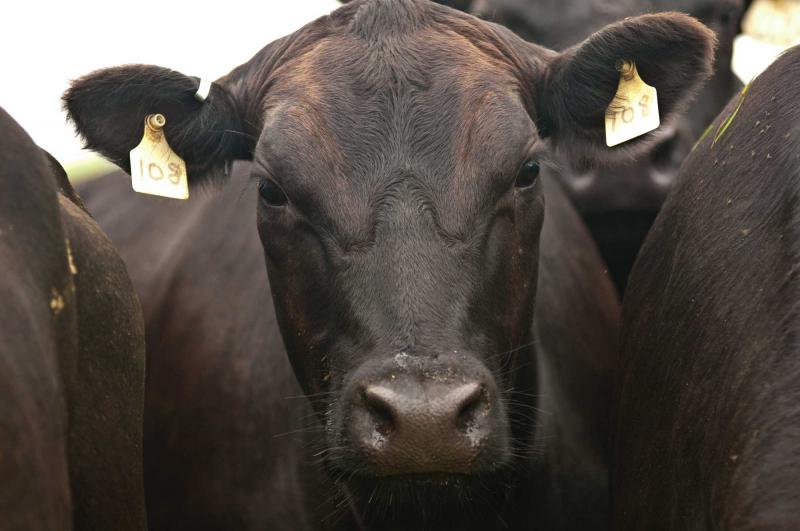Adele Harty
SDSU Extension Cow/Calf Field Specialist

Cattle mineral nutrition is complex and often confusing, but one strategy to help ranchers better evaluate their mineral program is to monitor mineral consumption. This goes back to the old adage, “You can’t manage what you don’t measure.”
Mineral supplement tags provide the recommended daily intake based on specific product formulations. Recommended intakes can vary widely depending on the brand and type of product, with the most common being 1 to 4 oz. per day for loose minerals. Producers should always read the mineral tag to know how much the cattle should be consuming and to help determine if their herd is actually consuming that recommended intake. There are a variety of ways to accomplish this.
Calculating Mineral Consumption
For the big picture, calculate pounds of mineral fed during the year. Multiply total pounds fed during the year by 16 to calculate the total ounces delivered. Divide ounces by 365 days. Finally, divide ounces delivered per day by the number of head in the herd to determine average mineral intake per head per day.
Example:
- 6,000 lbs of mineral per year × 16 oz per lb = 96,000 oz
- 96,000 oz ÷ 365 days = 263 oz per day
- 263 oz per day ÷ 100 head = 2.63 oz per head per day
Another way to monitor consumption is to keep a record of mineral delivery. Record the quantity of mineral delivered each time and how many days that quantity lasts. Monitoring this closely will help identify times when grass quality changes, which can influence changes in mineral consumption. For instance, cattle will consume mineral differently when grass is lush and growing rapidly compared to when it is dormant. The calculation is the same as outlined above, but the number of days changes based on frequency of delivery.
Example:
- 150 lbs × 16 oz per lb = 2,400 oz
- 2,400 oz ÷ 7 days = 343 oz per day
- 343 oz per day ÷ 100 head = 3.43 oz per head per day
Once consumption is calculated, management strategies can be implemented to overcome consumption issues. Forage and water samples can provide valuable information in assessing whether or not the mineral supplement complements the available forage and water to meet cattle nutrient requirements. This video provides guidance for collecting forage samples for mineral analysis, which can then be sent to a feed and water testing laboratory for mineral analysis. Lab results will help identify deficiencies, toxicities, and interactions to ensure the mineral supplement is providing the appropriate level of nutrients for the situation. Various factors can influence mineral consumption including age and experience of the animal, type and placement of mineral feeders, composition of mineral supplement, and changing forage quality and availability.
Management Strategies for Over-Consumption
Over-consumption of mineral in the short-term is not of great concern. Consider whether or not cattle have had access to mineral in the recent past. If mineral was not available for a period of time, cattle may over-consume for a short period of time to make up for nutrient deficiencies. If over-consumption continues for more than a week, other factors are likely involved. Depending on forage and water quality, the mineral supplement may not be meeting nutritional needs or cattle could be consuming it for the carrier, typically a protein-type product – over-consumption can also occur if forage protein is deficient. This has been observed in tame grass pastures in late summer in western South Dakota. Other management practices for over-consumption include moving mineral feeders further away from water sources, adding salt to reduce intake, changing mineral supplement products, or moving cattle to a fresh pasture.
Management Strategies for Under-Consumption
If consumption is less than desired and the supplement complements forage and water; dried molasses, dry distiller’s grain or soybean meal can increase palatability of the mineral. Inclusion rate of the feed may require some trial and error to find the optimum level of inclusion that results in targeted consumption. A starting point would be to add 1 part feed to 5 parts mineral. This would be approximately 10 lbs per 50 lb bag of mineral. If cattle over-consume the mineral due to the addition of feed, cut the added feed in half the next time you deliver mineral. Continue this process until the desired consumption is reached. Don’t forget to account for that added feed when calculating mineral consumption. For example, if the recommended intake is 4 oz per head per day of mineral, but 10 lbs of feed is added, the intake needs to increase to 4.8 oz per head per day. If consumption does not reach the desired level, consider changing minerals.
Taking time to monitor mineral consumption is an easy task that can help guide management decisions. Ensuring cattle are consuming mineral at the appropriate level is key to proper mineral nutrition and overall cattle health and performance. If you are interested in an Excel spreadsheet to monitor mineral consumption, please contact me, Adele Harty. I can also assist with interpretation of results and comparing the mineral supplement to requirements and potential modifications to the mineral supplementation program can be made.
SDSU iGrow
